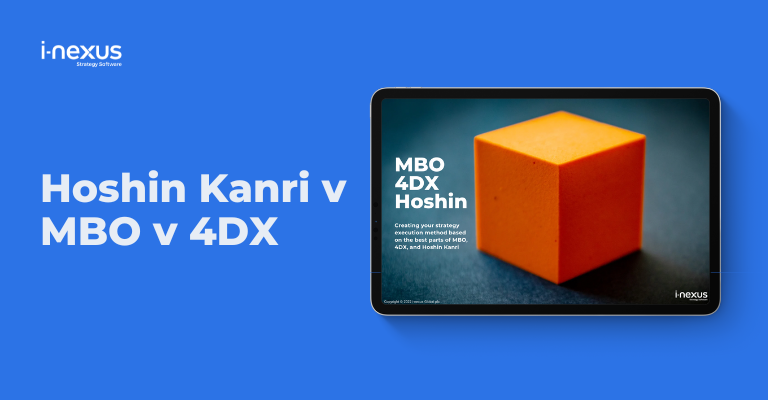How does Hoshin Kanri compare against the ever-prevalent 4DX and MBO strategic methodologies? We explore this and much more in this blog...
Written by: Carolyn Gibson, Senior Strategy Advisor
Strategy Execution is all the rage right now. Some of us are rushing to put brand new strategies into action in record time; others are using the pandemic to reevaluate and adjust their organization’s Strategy Execution processes.
We all feel the urgent need to get the right results fast.
The good news is that you don’t have to reinvent the wheel: great Strategy Execution techniques have been around for decades.
However, you do need to know the advantages and disadvantages of the different approaches, and then determine how best to apply them to your situation.
In the next three blogs, I will explore some of the main Strategy Execution methodologies out there and how each of them can be used alone, or together, to deliver your strategy.
In this blog I’m going to look at just three of them: Hoshin Kanri, 4DX, and MBO, and show how these tools are entirely complementary.
Let’s dive in to see how they can be deployed to build your organization’s Strategy Execution capability.
MBO: Management By Objectives
MBO (Management by Objectives, also sometimes called Management by Results) was put forward by Peter Drucker in 1954. He proposed it as a way to better engage employees in the delivery of an organization’s goals by giving employees a role in defining how they were going to help meet targets.
It was supposed to be a departure from the dark days of management by control, however, many companies implementing MBO in the 50s and 60s didn’t understand this.
Indeed, they pressured employees to achieve targets no matter what, which led to cheating, silo-thinking, and other undesirable side-effects.
This gave MBO an undeservedly bad name.
In truth, MBO is the heart of the modern performance appraisal process, where supervisors and supervisees agree together on what their goals and aspirations should be, how those align with the company’s vision, and how the accomplishment of these will be assessed, using the now-standard SMART goal definition process.
4DX: The Four Disciplines of Execution
“The Four Disciplines of Execution” was published by Covey and McChesney in 2012, and is, therefore, a much more recent contribution to the Strategy Execution toolkit.
It has a very simple message:
- Focus on a small number of “Wildly Important Goals” (WIGs)
- Identify and act on the small number of impactful activities that will drive progress
- Track progress with a “compelling scoreboard”
- Promote accountability with regular supportive reviews.
What 4DX brings to the table is an urgency at a team level that is driven by the concept of lead metrics.
What is it that we can do right now, how do we know we are achieving it, and how can we quickly adjust if necessary?
For example, to improve safety in a transport company we could refit all the vans with speed limiters, and the leading measure would be what percent of vans had been refitted.
If the refitting wasn’t going well, we could see it immediately on our scorecard and quickly switch to another supplier.
Hoshin Kanri
Hoshin Kanri, otherwise known as Policy Deployment, was introduced by Professor Yoji Akao in Japan in the 1950s.
It was popularized by Toyota in Japan and later Xerox and HP in the USA, and has since been adopted in many large and small organizations across the globe.
As an organization-wide process for strategy deployment and execution, it combines the MBO and 4DX philosophies in the continual process of:
- Engaging people in a process called Catchball to come to an agreement on a small number of measurable, actionable goals, thereby creating joint accountability
- Measuring progress through the use of the Bowling Chart, a time-based scorecard
- Driving quick progress through the use of reactive plan changes - the Countermeasures.
I’ve already written a number of articles about Hoshin Kanri already so click here to read more about the process and the toolkit.
However, Hoshin is really more of a philosophy than just a toolkit - it encompasses culture, processes and tools together, and therefore is often considered a total business system.
Bringing Hoshin, 4DX, and MBO together
Each of these tools can be used separately, however, Hoshin Kanri provides the perfect framework to make them work consistently together.

Creating alignment
Hoshin Kanri provides the overarching system for how your organization will work together to achieve its vision, its True North.
Through catchball, the various horizontal and vertical axes of the organization are engaged to choose the way forward, creating both focus and accountability on a few key improvement priorities.
Excellent execution
When it is time for execution, the Bowling Chart is the 4DX equivalent of the ‘compelling scorecard’ to help track progress.
Where leading metrics are showing insufficient progress, countermeasures can be launched to quickly make up ground.
Seeking motivation?
When you need to motivate and manage a team member to be productive within your team, MBO is your tool.
It allows you to revisit together what the company goals are and what specific actions the employee can contribute to driving progress through the scorecard.
Hoshin Kanri provides the context for that conversation, ensuring that each individual’s contribution is aligned with the organization as a whole.
Tips for success
- Don't rate individual performance
To be clear, the organization’s objectives and goals, created as part of the Hoshin Kanri process, should never be used to rate individual performance.
Whether an organization achieves its goals or not is down to a number of factors outside of individual control, including environmental changes (COVID-19 has been a painful reminder of this).
- Leading metrics are not enough
While they help quickly identifying if progress is being made, they still must be linked back to the lagging metrics which measure progress against the overarching goals.
In the case of speed limiters above, the leading metric might be the installation of the limiters, but the key lagging metric is safety.
If safety isn’t improved as a result of installation, then Hoshin Kanri dictates the need to introduce a different countermeasure, perhaps better brakes or training for drivers.
- A no-blame culture is key to success
At the individual, team, and organizational level, successful Strategy Execution is primarily about trial and error.
If directors, managers, and/or their employees are afraid to fail, there will only be three possible outcomes:
a) They will play it safe
b) They will play it alone; or
c) They will play it crooked.
In all scenarios, the organization will fail to achieve its potential.
Which methodology comes out on top?
I would hazard that that isn't the correct question to ask.
Indeed, there are a number of Strategy Execution toolsets out there, but before you bring any one of them into your organization, make sure you understand the fundamental principles of each and how they might slot together to make your organization fitter and faster.
We all know how much is at stake.
Continue learning about Hoshin Kanri
Click here for further information on Hoshin Kanri, and stay tuned for the next blog on the Bowling Chart and how it is used to measure success.
For more, continue your journey with these recommendations:
- The Hoshin Kanri X-Matrix: The What, How, Why, Benefits and more: Discover how the X-Matrix works and how you can make your own in our free Excel template
- Danaher, Ingersoll Rand and Xerox: Policy Deployment in Practice: Learn why the experiences of these companies can teach us a lot about adopting Policy Deployment / Hoshin Kanri.
- Download our Hoshin Kanri eBook: Read how Hoshin Kanri is supporting organizations to drive great business results, how two businesses have used the methodology to build their business systems, case studies and more.
About the author
Carolyn Gibson is a senior strategy advisor and certified Hoshin Kanri facilitator working with Fortune 500 companies on building their Strategy Execution capabilities. Her career spans disciplines, industries and locations for over twenty years, with a golden thread running throughout of an obsessive focus on the mechanical detail of how organizations achieve their goals.




